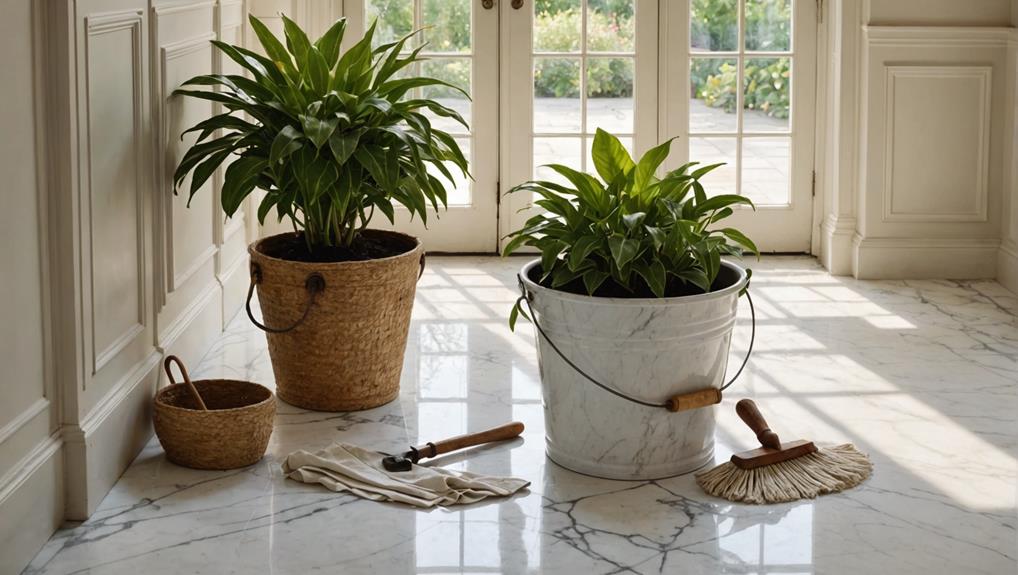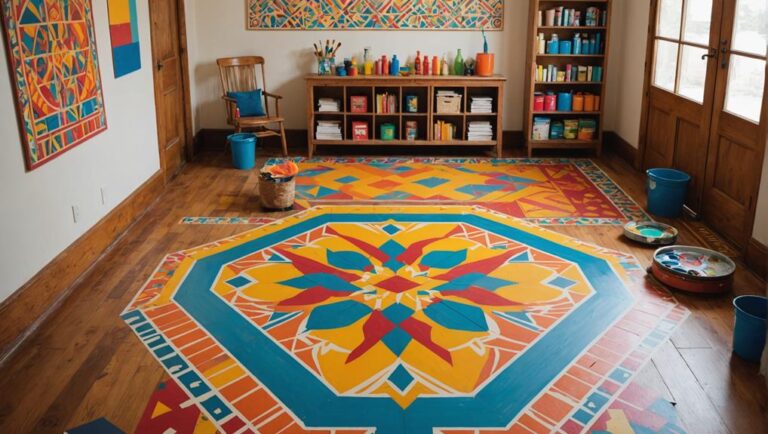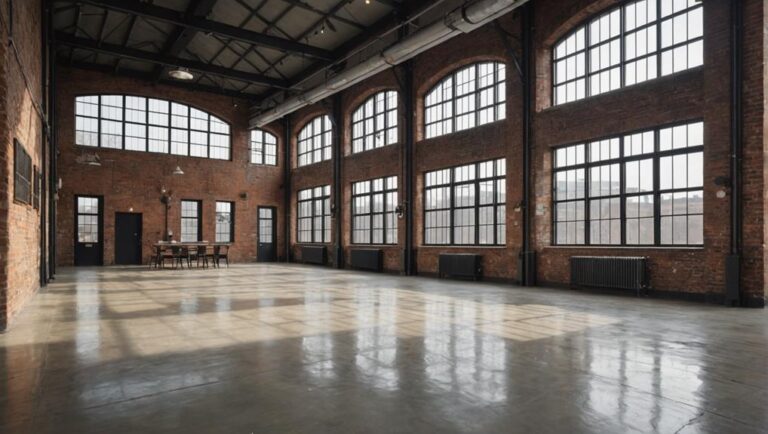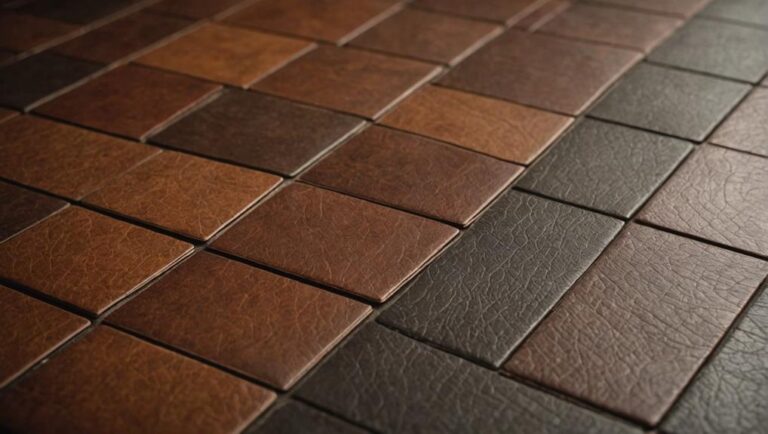To clean antique marble floors, start by evaluating their condition for any visible damage. Use a soft-bristle broom and microfiber cloths to gently remove dust. For cleaning, opt for a pH-balanced cleaner, avoiding acidic solutions that can cause etching. Address stains by identifying their type and applying a neutral cleaner carefully. When deep cleaning, work in sections and use soft brushes to avoid scratches. After cleaning, thoroughly rinse and dry to prevent water spots, and consider applying a penetrating sealer for added protection. Understanding these techniques will help maintain the elegance of your marble floors effectively.
Assessing the Condition
Before you begin cleaning antique marble floors, it is crucial to assess their condition. Start by inspecting the surface for visible damage, such as cracks, chips, or discoloration. Understanding the marble history can provide insight into its durability and any previous restoration techniques applied. Antique marble often exhibits unique characteristics due to age, which can influence your cleaning approach.
Next, evaluate the level of dirt and grime buildup. Use a flashlight to identify any stains or areas requiring special attention. Stains may indicate the need for specific cleaning agents or techniques, as some might react negatively with the marble. Always prioritize safety by wearing gloves and a mask, especially when handling chemicals for deeper cleaning or restoration.
Consider the finish of the marble. Polished surfaces require different care compared to honed finishes. For polished marble, avoid abrasive cleaners that can scratch the surface. Conversely, honed marble may benefit from gentle scrubbing to remove embedded dirt.
Gathering the Right Supplies
Once you've evaluated the condition of your antique marble floors, the next step is gathering the right supplies for cleaning. Having the appropriate cleaning tools guarantees you'll maintain the integrity and appearance of your marble. Here's a list of essential items to take into account:
- Soft-bristle broom: For gentle dusting without scratching.
- Microfiber mop: To effectively capture dirt and debris without harsh chemicals.
- pH-balanced cleaner: Designed specifically for marble surfaces to prevent etching.
- Soft, absorbent towels: For drying and polishing post-cleaning.
Before you begin, make sure to check for any additional supplies based on your maintenance schedule. Regular upkeep will require a more extensive toolkit, so think about the following:
- Bucket: For mixing cleaning solutions and rinsing.
- White vinegar: While often discouraged for regular use, it can be effective in diluted form for specific stains.
- Sealer: To protect your floors after cleaning, ensuring longevity.
When selecting cleaning tools, prioritize those that are soft and non-abrasive. Harsh materials can cause irreversible damage to your antique marble, leading to costly repairs. Additionally, avoid acidic or harsh cleaners, as they can etch the surface. As you gather these supplies, keep safety in mind. Verify your workspace is well-ventilated and that you're using gloves to protect your skin from any cleaning agents. With the right tools in hand, you'll be well-equipped to maintain your antique marble floors effectively.
Dusting and Sweeping Techniques
To maintain the pristine condition of your antique marble floors, effective dusting and sweeping techniques are essential. Start by gathering high-quality microfiber cloths, which are gentle yet effective at trapping dust and dirt without scratching the surface. Microfiber's unique properties allow it to capture particles rather than just pushing them around.
Begin dusting by lightly dampening a microfiber cloth with water or a suitable marble-safe cleaner. Wipe the floor in a systematic manner, focusing on one section at a time. This guarantees you cover all areas thoroughly. When dusting, always move in a straight line and avoid circular motions, as this can lead to streaks or unintentional scratches.
For sweeping, use a soft-bristled broom to avoid damaging the marble. Employ sweeping angles that allow you to gather debris without lifting the broom too high, as this can scatter dust back onto the surface. Aim for low, smooth sweeps, and make sure to sweep towards a dustpan rather than lifting the broom off the floor.
Periodically check the broom for accumulated dirt or debris to maintain its effectiveness. After sweeping, consider a second pass with a dry microfiber cloth to capture any remaining dust particles. By following these dusting and sweeping techniques, you'll guarantee your antique marble floors remain clean, safe, and beautiful, preserving their elegance for years to come.
Spot Cleaning Stains
When spot cleaning stains on your antique marble floors, it's essential to first identify the type of stain you're dealing with, as different stains require specific treatments. Next, use gentle cleaning solutions to avoid damaging the marble's surface. Always test your cleaning solution in an inconspicuous area to guarantee it won't harm the finish.
Identify the Stain Type
Identifying the type of stain on your antique marble floor is essential for effective spot cleaning. Different stains require different stain removal techniques, and knowing the common stain types will help you select the best approach. Here are some common stain types you might encounter:
- Oil-based stains: Such as grease or food spills
- Water stains: Often caused by moisture or mineral deposits
- Organic stains: Resulting from coffee, wine, or plant matter
- Rust stains: Typically from metal objects left on the surface
Once you've identified the stain, you can determine the appropriate cleaning method. For instance, oil-based stains may require a specific solvent to break down the grease, while water stains can often be removed with a gentle acidic solution. Be cautious with acidic cleaners, as they can damage marble. Always test any cleaning solution in an inconspicuous area first, ensuring the safety of your floor. By accurately identifying the stain type, you'll be better equipped to choose effective stain removal techniques that preserve the beauty and integrity of your antique marble flooring.
Use Gentle Cleaning Solutions
Gentle cleaning solutions are essential for effectively spot cleaning stains on antique marble floors without causing damage. When dealing with marble, it's vital to select cleaners that maintain a neutral pH balance, as acidic or alkaline substances can etch the surface. You should consider using natural cleaners, such as a mixture of warm water and a few drops of mild dish soap or white vinegar diluted with water. These solutions are not only safe for the marble but also environmentally friendly.
Before applying your chosen solution, gently blot the stain with a soft cloth to absorb any excess material. Then, using a clean cloth, apply your natural cleaner to the stained area and allow it to sit for a few minutes. This waiting period helps the solution penetrate the stain effectively. After that, gently scrub the area with a soft-bristled brush or sponge, being careful not to use excessive force, which could scratch the marble.
Once the stain is removed, rinse the area thoroughly with clean water to eliminate any residue from the cleaning solution. Finally, dry the spot completely using a soft towel to prevent water spots and maintain the floor's shine.
Test in Inconspicuous Area
Before applying any cleaning solution to your antique marble floors, it is crucial to test it in an inconspicuous area. This precaution helps guarantee that the cleaning method you choose won't damage the marble. Here are some effective test methods you might consider:
- Water Test: Apply a few drops of water to see if the surface absorbs it, indicating porosity.
- pH Test: Use a pH strip to determine if your cleaning solution is acidic or alkaline, as marble is sensitive to extremes.
- Spot Test: Apply a small amount of the solution directly on the selected area and observe for any immediate discoloration.
- Dwell Time: Allow the solution to sit for a few minutes before wiping it away to evaluate the test results.
Deep Cleaning Methods
When it comes to deep cleaning antique marble floors, employing the right techniques is essential to preserve their beauty and integrity. Begin by gathering your supplies, which should include a pH-neutral cleaner specifically designed for marble. Avoid acidic or abrasive products that could damage the surface. Dilute the cleaner according to the manufacturer's instructions, and use a soft mop or cloth to apply it gently.
Next, focus on stubborn stains or areas of heavy grime. For these, consider employing gentle polishing techniques. A marble polishing powder can be effective; just sprinkle a small amount on the stained area and buff it with a soft cloth in a circular motion. This not only helps lift the stain but also enhances the shine of your floor.
If your antique marble floor shows signs of wear, you might want to explore restoration methods. A professional diamond polishing service can restore the floor's original luster and remove scratches or imperfections. If you prefer a DIY approach, use a poultice made from baking soda and water to draw out any embedded stains. Apply it to the stain, cover it with plastic wrap, and let it sit for 24 hours before gently rinsing.
Always remember to dry the floor thoroughly after cleaning to prevent water spots. By following these precise deep cleaning methods, you can maintain the elegance and longevity of your antique marble floors.
Avoiding Harmful Chemicals
Choosing the right cleaning products is vital for maintaining the integrity of antique marble floors, as even a single use of harmful chemicals can lead to irreversible damage. Using aggressive cleaners may strip away the natural beauty and patina of your marble, so it's important to opt for safer options. Here are some key points to keep in mind:
- Avoid acidic cleaners: Products containing vinegar or lemon juice can etch and dull the surface.
- Skip ammonia-based solutions: These can cause discoloration and weaken the marble.
- Don't use abrasive tools: Scrubbing pads may scratch the surface, compromising its finish.
- Read labels carefully: Verify the products are specifically formulated for marble.
Instead, focus on natural alternatives and eco-friendly products that are both effective and safe. Baking soda mixed with water can create a gentle paste, perfect for spot cleaning stubborn stains. Additionally, a solution of mild dish soap and warm water can be used for routine cleaning without risking damage.
Always rinse thoroughly after using any cleaning solution to avoid residue buildup, which can attract dirt and grime. Regular maintenance with safe products not only preserves the appearance of your antique marble floors but also supports a healthier indoor environment. By being mindful of your choices, you can enjoy the elegance of your flooring without compromising its integrity or your safety.
Sealing and Protecting Marble
Sealing and protecting your antique marble floors is essential for preserving their beauty and longevity. It helps guard against stains, scratches, and moisture penetration, which can lead to irreversible damage. To effectively seal your marble, you'll want to employ the right marble sealing techniques tailored to the specific type of marble you have.
Start by making certain your floors are clean and dry. Any residue can interfere with the sealing process. Once cleaned, choose a high-quality penetrating sealer specifically designed for marble. This type of sealer absorbs into the stone, creating an internal barrier against moisture and stains. Apply the sealer using a clean, soft cloth or a microfiber applicator, ensuring even coverage across the surface. Follow the manufacturer's instructions for drying times and reapplication frequency.
In addition to sealing, consider applying protective coatings that offer a further layer of defense. These coatings act as a shield against everyday wear and can enhance the marble's natural luster. Look for coatings that are non-toxic and safe for indoor use, especially if you have children or pets.
Regularly inspecting the sealed surface will help you identify any areas that may require resealing. If you notice any dull spots or stains, it may indicate that the sealant has worn off and needs reapplication. By following these steps, you'll make certain that your antique marble floors remain stunning and protected for years to come.
Regular Maintenance Tips
Even with proper sealing and protection, regular maintenance is essential for keeping your antique marble floors in pristine condition. Implementing a routine of preventive care guarantees that your floors remain beautiful and safeguarded against damage. Here are some key maintenance tips to take into account:
- Sweep Daily: Removing dust and debris helps prevent scratches.
- Use Soft Cloths: When cleaning, always opt for soft cloths to avoid abrasions.
- Choose the Right Cleaners: Use pH-neutral cleaners specifically designed for marble.
- Apply Floor Mats: Place mats at entry points to reduce dirt and moisture.
Incorporating these practices into your seasonal upkeep can greatly extend the life of your flooring. Start by vacuuming or sweeping your antique marble regularly to eliminate grit and dirt. This simple step can prevent scratches that accumulate over time.
For deeper cleaning, dampen a soft cloth with a pH-neutral solution; harsh chemicals can etch and dull the surface. Following this, you should regularly inspect the sealant's integrity, reapplying it as necessary to maintain its protective barrier against spills and stains.
Additionally, think about utilizing coasters and mats in areas with heavy foot traffic or moisture exposure. These small adjustments contribute immensely to preventive care.
Frequently Asked Questions
Can I Use Vinegar to Clean Antique Marble Floors?
You shouldn't use vinegar to clean antique marble floors. Vinegar's acidic nature can cause significant damage to the stone, leading to etching and dullness. It's essential to avoid acidic cleaners altogether, as they can compromise the integrity of the marble over time. Instead, opt for pH-neutral cleaners specifically designed for stone surfaces to guarantee your floors remain protected and maintain their beauty. Always prioritize safety by selecting the right cleaning products.
How Often Should I Deep Clean My Marble Floors?
Marvelous marble maintenance is essential for preserving your floors! You should deep clean your marble floors every 1-3 months, depending on traffic and usage. Regular cleaning frequency helps prevent stains and scratches, guaranteeing your marble remains stunning. Always use pH-neutral cleaners to avoid damage. For safety, make sure the area is well-ventilated and avoid harsh chemicals that can harm both the surface and your health. Consistent care keeps your marble looking magnificent!
What Are the Best Tools for Cleaning Antique Marble?
When considering the best tools for cleaning antique marble, you'll want to prioritize safety and effectiveness. Use a pH-neutral cleaner specifically formulated for marble floor maintenance to avoid damage. A soft microfiber mop is ideal for applying the cleaner without scratching. For deeper antique marble restoration, a gentle scrubbing pad can help remove stubborn stains, but always test on a small area first. Regular maintenance with these tools will preserve your antique marble's beauty.
Can I Hire a Professional for Marble Floor Cleaning?
Can you really guarantee the safety and longevity of your marble floors by hiring a professional? Engaging professional services can be advantageous, particularly for antique marble. However, cost considerations are essential; while hiring experts might seem pricey, their expertise can prevent damage and costly repairs later. Always verify their credentials and inquire about their cleaning methods to guarantee they prioritize safety while preserving your floors' beauty. It's a worthwhile investment in the long run.
How Can I Remove Scratches From Antique Marble?
To remove scratches from antique marble, you'll want to focus on scratch repair techniques. Start by evaluating the depth of the scratches; for light scratches, a polishing technique using a marble polishing compound can work wonders. Apply the compound with a soft cloth, buffing in circular motions. For deeper scratches, consider using a finer grit sandpaper followed by a polishing pad. Always test in an inconspicuous area first to confirm safety and effectiveness.




